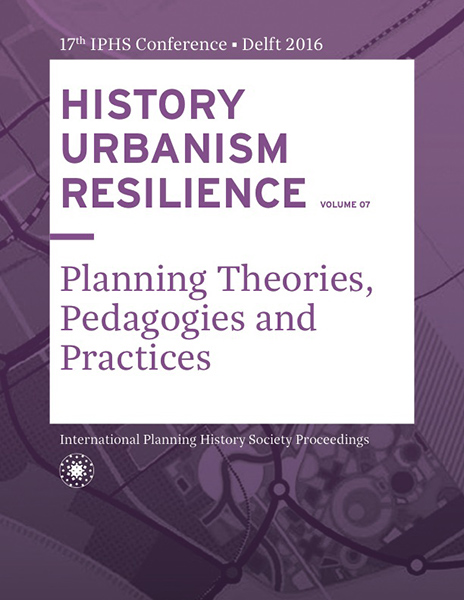On ecology and design: about the Brussels school heritage and perspective on urban metabolism
DOI:
https://doi.org/10.7480/iphs.2016.7.1340Abstract
The paper aims to highlight the interrelation between ecological studies and urban planning, in particular with regard to the Brussels case, given both its pioneer works and the current revival on urban metabolism. As early as the ‘70s of the last century, in continuity with the organic concept of the XIX century metropolis (the regionalism of Geddes), the ecologist Duvigneaud studied Brussels as an ecosystem. His approach integrated a scientific and socio-natural understanding of urban metabolism. Afterwards, further studies on urban metabolism have flowed into industrial ecology, the study of the material and energy circulation, narrowing the scope of investigation on urban space and nature. More recently, there has been a strong return on the debate of the Brussels urban metabolism. In order to boost the regional economic and social development as well as to meet the urban environmental challenges, new regional programs and plans are asking the urban projects to integrate a strong metabolic perspective. However, it remains to better understand how and to which extent the discipline of urbanism can actually draw from urban metabolism studies, and, in turn, what it can bring to the research field. In answering this question, we look back in particular to the influences and relations between ecological studies and urban design and planning in the recent history of Brussels. On the one hand, the results show that, despite the rising interest in the subject, until now, design and planning practice, in Belgium, seems to have little learnt from urban metabolism studies, showing few significant contributions to the discipline. On the other hand, it clearly emerges that stronger socio-natural perspective is needed in order for urban design and planning to steer the transformation of the city towards a more resilient urban metabolism.References
Aron, Jacques. Le Tournant de L’urbanisme Bruxellois : 1958-1978. Librairie “Du Monde Entier.” Bruxelles, 1978.
Ayres, Robert U., and Leslie Ayres. A Handbook of Industrial Ecology. Edward Elgar Publishing, 2002.
Banham, Reyner. Los Angeles : The Architecture of Four Ecologies. Penguin Books., 1973.
“BATir - Building, Architecture & Town Planning (ULB).” Accessed April 5, 2016. http://batir.ulb.ac.be/index.php/component/content/article/19-research/aia/335-research-aia-sust-um.
Billen, Gilles, F. Toussaint, P. Peeters, J.P. Vanderborght, M. Sapir, and A. Steenhout. “L’Ecosystème Belgique : Essai D’écologie Industrielle.” Bruxelles : Centre de recherche et d’information socio-politiques, 1983.
Clément, Gilles. Le Jardin En Mouvement : De La Vallée Au Jardin Planétaire. Sens & Tonka. Vol. 5. Calepin 11/24. Paris, n.d.
Clift, Roland, Angela Druckman, Ian Christie, Christopher Kennedy, and James Keirstead. “Urban Metabolism: A Review in the UK Context.” Foresight Future of Cities Project, September 2015.
Corijn, Eric, Jean de Salle, Jean-Louis Genard, Christian Kesteloot, Christian Vandermotten, and Pierre Vanderstraeten. Où va Bruxelles? Visions Pour La Capitale Belge et Européenne. ASP Academic and Scientific Publishers. Cahiers Urbains, 2013.
De Solà-Morales Rubió, Ignasi. “Terrain Vague.” Anyplace, MIT Press, 14 (1995): 118–23.
Doxiadis, Constantinos A. EKISTICS: An Introduction to the Science of Human Settlements. First Edition edition. Oxford University Press, 1968.
Duvigneaud, Paul. Les Sites Semi-Naturels de L’écosystème Bruxelles : Interpénétration de L’environnement Physique et de L’environnement Sémiotique. Centre d’études Jacques Georgin., 1990.
Duvigneaud, Paul, and Simone Denayer-De Smet. “L’ecosystéme Urbain Bruxellois.” In Productivité Biologique En Belgique, Editions Duculot., 608–13. Travaux de La Section Belge Du Programme Biologique International. Paris, Gembloux: P. Duvigneaud and P. Kestemont, 1977.
Duvigneaud, Paul. “Études Écologiques de l’Écosystème Urbain Bruxellois: Contribution no 1 à 4: L’écosystème ‘Urbs’’.” Mémoires de La Société Royale de Botanique de Belgique 6 (n.d.): 5–35.
Duvigneaud, Paul, Simone Denaeyer-De Smet, and Martin Tanghe. “Carte Écologique de L’occupation Du Sol et Des Degrés de Verdurisation de L’agglomération Bruxelloise : Situation Mars 1975.” Agglomération de Bruxelles, Service de l’environnement, 1977.
EcoRes, ICEDD, and BATir. “Métabolisme de La Région de Bruxelles-Capitale.” IBGE, 2015.
Erkman, Suren. Vers une écologie industrielle. ECLM, 2004.
Gandy, Matthew, in conversation with Daniel Ibañez, and Nikos Katsikis. “On Circulations and Metabolisms: Challenges and Prospects.” Grounding Metabolism, New Geographies, 6 (August 2014): 174–83.
Gandy, Matthew. “Marginalia: Aesthetics, Ecology, and Urban Wastelands.” Annals of the Association of American Geographers 103, no. 6 (November 1, 2013): 1301–16. doi:10.1080/00045608.2013.832105.
Golubiewski, Nancy. “Is There a Metabolism of an Urban Ecosystem? An Ecological Critique.” Ambio 41, no. 7 (November 2012): 751–64. doi:10.1007/s13280-011-0232-7.
IEB. Bruxelles En Mouvements, January 2015, Périodique édité par Inter-Environnement-Bruxelles, Fédération de Comités de Quartier et Groupes d’Habitants edition.
Karakiewicz, Justyna “Urban Metabolism of Low Carbon Cities.” In 47th ISOCARP Congress. Wuhan, China, 2011.
Kennedy, Christopher, S. Pincetl, and P. Bunje. “The Study of Urban Metabolism and Its Applications to Urban Planning and Design.” Environmental Pollution 159, no. 8–9 (August 2011): 1965–73. doi:10.1016/j.envpol.2010.10.022.
Tanghe, Martin, Paul Duvigneaud, and M. Jouve-Barbezat. “Études Écologiques de l’Écosystème Urbain Bruxellois: Contribution No 2: Premier Aperçu Des Facteurs Écologiques Du Métabolisme de L’agglomération Bruxelloise.” Mémoires de La Société Royale de Botanique de Belgique 6 (n.d.): 37–56.
Reed, Chris, and Nina-Marie Lister. “Ecology and Design: Parallel Genealogies.” Places Journal, April 14, 2014. https://placesjournal.org/article/ecology-and-design-parallel-genealogies/.
Romańczyk, Katarzyna M. “Transforming Brussels into an International City – Reflections on ‘Brusselization.’” Cities 29, no. 2 (April 2012): 126–32. doi:10.1016/j.cities.2011.08.007.
Secchi, Bernardo. “A New Urban Question 3: When, Why and How Some Fundamental Metaphors Were Used.” In Metaphors in Architecture and Urbanism: An Introduction, Transcript Verlag., 123–32. A. Gerber & B. Patterson, 2013.
Vanderstraeten, Pierre, Stefan De Corte, Bernard Deprez, and B. Thielemans. “Brussels, a Sustainable City.” Accessed April 5, 2016. http://brusselsstudies.be/medias/publications/EN_72_CFB4.pdf.
Wachsmuth, David. “Three Ecologies: Urban Metabolism and the Society-Nature Opposition.” The Sociological Quarterly 53, no. 4 (September 1, 2012): 506–23. doi:10.1111/j.1533-8525.2012.01247.x.

